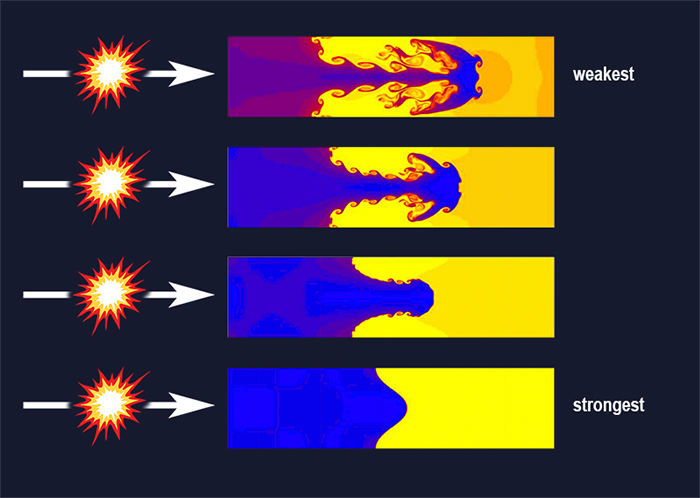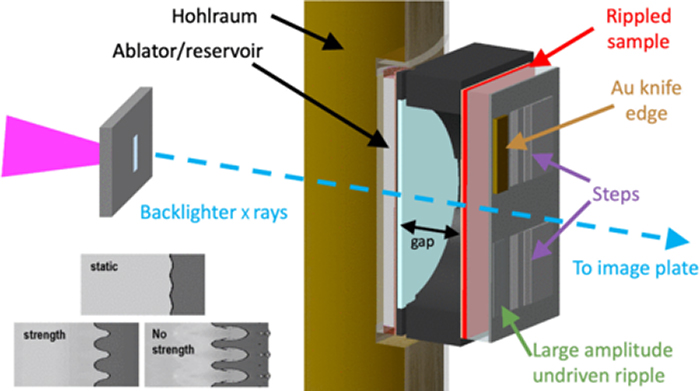NIF Research Finds Lead Gets Harder Under Extreme Conditions
November 20, 2019
A team of LLNL researchers has demonstrated that lead — a metal so soft that it’s difficult to machine under normal conditions — responds much like other, stronger metals when rapidly compressed at high pressure. The research was reported in a new paper published as an “Editors’ Suggestion” in Physical Review Letters
“This is the first paper to directly probe the strength of a heavy metal at Earth-core pressures following a phase transformation,” said LLNL physicist Andy Krygier, the lead author. “The pressure and the phase transformation turned soft lead very hard. This hardening had been predicted, but actually seeing that take place was quite remarkable and exciting for our team.”
“It’s clear now — metallurgy isn’t the same at high pressure,” added Rob Rudd, LLNL material strength theorist and co-author. “We have been fortunate enough to get a first look at what’s different at this extreme regime.”
The paper also was highlighted by a “Viewpoint” article in Physics.
 The application of stress to a solid causes the material to flow, a phenomenon known as Rayleigh-Taylor instability. This flow causes ripples patterned on the material surface to grow, forming jet-like structures coming off the surface. Credit: Shengtai Li and Hui Li/Los Alamos National Laboratory; adapted by Joan Tycko/APS
The application of stress to a solid causes the material to flow, a phenomenon known as Rayleigh-Taylor instability. This flow causes ripples patterned on the material surface to grow, forming jet-like structures coming off the surface. Credit: Shengtai Li and Hui Li/Los Alamos National Laboratory; adapted by Joan Tycko/APS This research is part of a series of NIF high-pressure materials science campaigns led by co-author Hye-Sook Park aiming to reveal material properties at extreme conditions. Materials exhibit a wide range of exotic behaviors at high pressure, and NIF, the world’s largest and highest-energy laser, provides the capability to drive experimental samples to pressures several million times the pressure of the atmosphere — similar to those found at the center of the Earth.
To infer the high-pressure material strength, the team’s experiments exploited a phenomenon called the Rayleigh-Taylor (RT) instability, which occurs when material is accelerated across different densities. They employed precisely formed rippled samples that seeded RT instability, causing ripple growth in a controlled manner during the high-pressure conditions.
The RT growth of surface perturbation occurs due to material density variations at the interface. This growth, however, can be changed by the material flow stress. A strong material will produce less growth than a weak one, as measured using an x-ray diagnostic available at NIF. By combining results from multiple experiments, the researchers compared the evolution of the RT growth over time to predictions from simulations testing various strength models.
“Material strength at high pressure and strain-rate is notoriously difficult to model as it is influenced by effects that occur over many different scales,” Krygier said, “all the way from the smallest scales that take into account how atoms bond to each other to the explicitly macroscopic scale.
“We have experimentally validated a new strength model in the high pressure, high strain-rate regime with careful measurements using techniques developed over many years.” he said. “This work truly demonstrates the ability of LLNL to solve hard and important problems by harnessing the unique capabilities and experts across so many different domains.”
Park highlighted several innovations that made the lead experiments possible, including multi-layer reservoirs designed to keep the lead solid as it was compressed to extremely high pressure; functionality that enabled direct comparison of the strength of pure and alloy samples; in-situ radiographic standards which significantly reduced the error bars; and important advancements in target fabrication.
“This endeavor took multiple years to develop,” Park said.
 Cutaway diagram of the experimental setup, including the hohlraum, multilayer ablator/reservoir, rippled sample pack- age, and backlighter. Bottom left: initial ripples and ripple-growth simulations with and without strength.
Cutaway diagram of the experimental setup, including the hohlraum, multilayer ablator/reservoir, rippled sample pack- age, and backlighter. Bottom left: initial ripples and ripple-growth simulations with and without strength. Krygier also said the researchers relied heavily on the “the expertise and capabilities” of the LLNL Target Fabrication Team.
“Among the many small miracles that take place in order to perform this work,” he said, “our experiments require very thin, large hohlraums, careful design and characterization of the low-density foams, and precisely formed ripples. The team has learned how to regularly do all of this including, crucially, production of high-quality ripples in a range of materials with vastly different properties and with a range of amplitudes and wavelengths.”
In addition to the specialized targets, the interpretation and understanding of the lead strength in this unique regime required a new strength model created by co-author Rudd. This theory is fed to the sophisticated simulation tools that predict experimental observables using LLNL’s high- performance computing capability. This integrated effort made it possible to make meaningful interpretations of the experimental results.
Looking ahead, the team will continue research in this area by investigating lead alloys, as well as compressing samples to higher pressures. Results from future experiments will guide development of new strength models for materials under extreme conditions.
Co-authors also included Philip Powell, James McNaney, Channing Huntington, Shon Prisbrey, Bruce Remington, Rob Rudd, Damian Swift, Christopher Wehrenberg, and Tom Arsenlis from LLNL and Peter Graham, Edward Gumbrell, Matt Hill, Andy Comley, and Steve Rothman from the United Kingdom’s Atomic Weapons Establishment.
—Breanna Bishop
Follow us on Twitter: @lasers_llnl



